Small overlap front: driver-side
Rating applies to 2014-19 models built after August 2013
Tested vehicle: 2014 Ford Fiesta S 4-door
The Ford Fiesta was introduced in the 2011 model year. Beginning with 2014 models built after August 2013, the standard autolock feature, which locks all doors when the vehicle speed exceeds 12 mph, was reprogrammed to prevent consumers from disabling this feature. (Information about when a specific vehicle was manufactured is on the certification label typically affixed to the car on the driver door or adjacent B-pillar.)
Drivers of cars built earlier can assure the same level of protection by keeping the autolock feature enabled for cars with power door locks or locking all doors manually. The small overlap frontal ratings also apply to the hatchback version of the Fiesta, also introduced in the 2011 model year.
| Evaluation criteria | Rating |
|---|---|
| Structure and safety cage | |
| Driver injury measures | |
| Head/neck | |
| Chest | |
| Hip/thigh | |
| Lower leg/foot | |
|
Driver restraints and dummy kinematics
The dummy’s head barely contacted the frontal airbag before sliding off the left side as the steering column moved 12 cm to the right. Additionally, the seat belt allowed excessive forward excursion of the dummy’s head and torso, contributing to the head hitting the instrument panel. The side curtain airbag deployed but does not have sufficient forward coverage to protect the head from contact with forward side structure and outside objects, and the driver's seat tipped forward and toward the B-pillar. | |
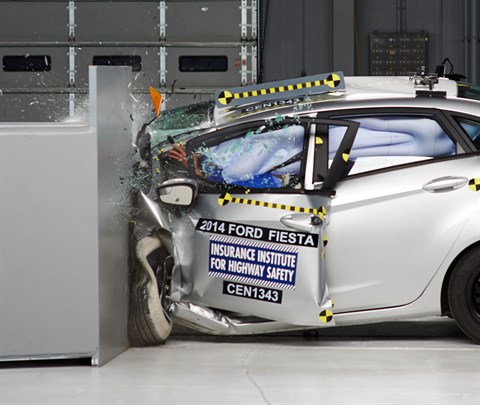
Action shot taken during the small overlap frontal crash test.
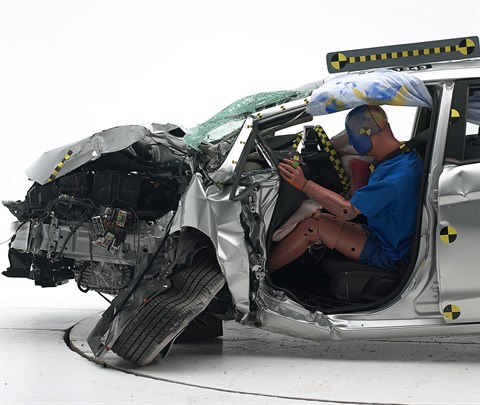
The dummy's position in relation to the door frame, steering wheel, and instrument panel after the crash test indicates that the driver's survival space was not maintained well.
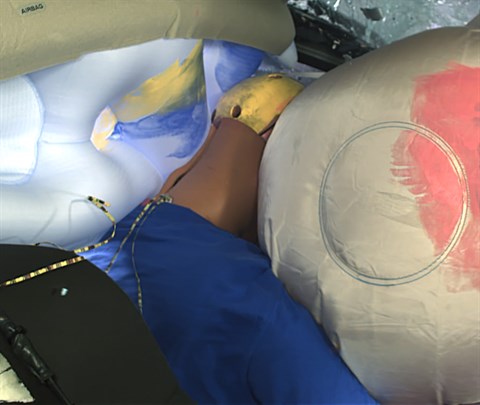
During the crash, the dummy's head and torso barely contacted the airbag before sliding off to the left as the steering column moved to the right. The seat belt allowed the dummy to move too far forward, the driver's seat pitched forward and tipped outward, and the head hit the instrument panel.
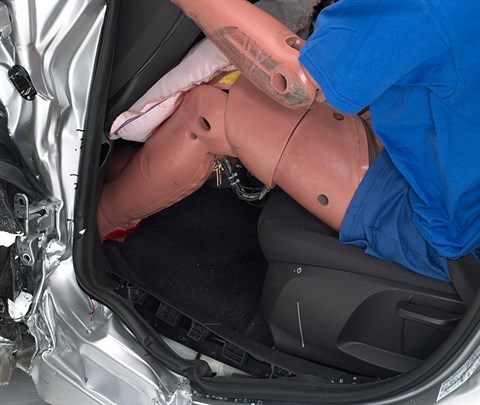
Door hinge pillar and instrument panel intrusion contributed to a moderate risk of injury to the left lower leg.
Moderate overlap front: original test
Rating applies to 2011-19 models
Tested vehicle: 2011 Ford Fiesta SE 4-door sedan
The Ford Fiesta sedan was introduced in the 2011 model year. The frontal ratings also apply to the hatchback version of the Fiesta, also introduced in the 2011 model year.
| Evaluation criteria | Rating |
|---|---|
| Overall evaluation | |
| Structure and safety cage | |
| Driver injury measures | |
| Head/neck | |
| Chest | |
| Leg/foot, left | |
| Leg/foot, right | |
| Driver restraints and dummy kinematics | |
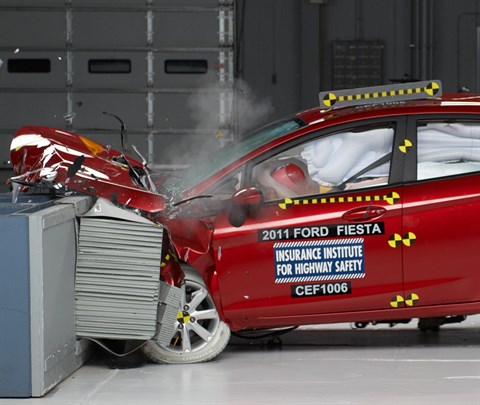
Action shot taken during the frontal offset crash test.
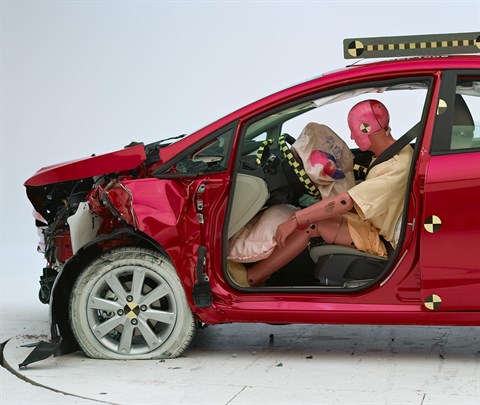
The dummy's position in relation to the steering wheel and instrument panel after the crash test indicates that the driver's survival space was maintained very well.
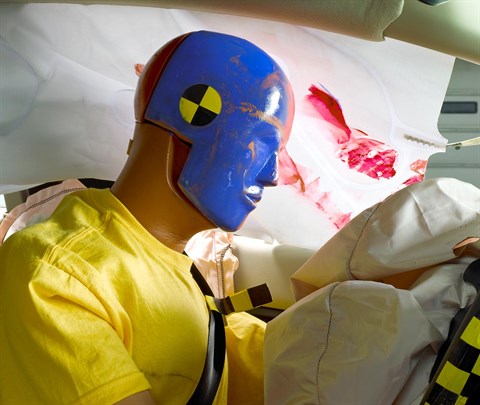
Smeared greasepaint indicates where the dummy's head contacted the side curtain airbag during rebound.
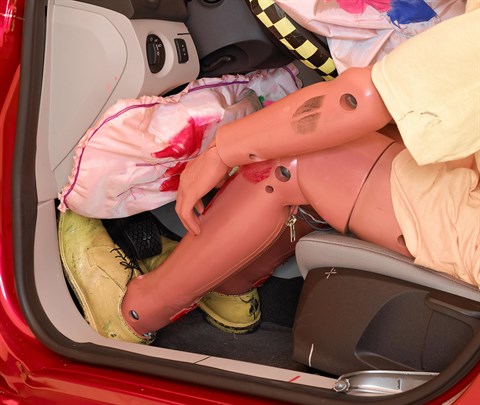
Intrusion into the driver's space was minimal, and all leg and foot injury measures were low. Smeared greasepaint indicates where the dummy's knees and shins contacted the knee airbag.
Side: original test
Rating applies to 2014-19 models
Tested vehicle: 2014 Ford Fiesta Titanium 4-door with standard front and rear head curtain airbags and standard front seat-mounted torso airbags
The Ford Fiesta sedan was introduced in the 2011 model year. The side impact crash test ratings also apply to the hatchback version of the Fiesta, also introduced in 2011. Beginning with 2014 models, design changes were made to the seat-mounted side torso airbags for front seat occupants and to the front door structure and trim. Side ratings are assigned by the Institute based on a test of a 2014 model conducted by Ford.
| Evaluation criteria | Rating |
|---|---|
| Overall evaluation | |
| Structure and safety cage | |
| Driver injury measures | |
| Head/neck | |
| Torso | |
| Pelvis/leg | |
| Driver head protection | |
| Rear passenger injury measures | |
| Head/neck | |
| Torso | |
| Pelvis/leg | |
| Rear passenger head protection | |
Roof strength
Rating applies to 2011-19 models
Tested vehicle: 2011 Ford Fiesta SE 4-door hatchback
| Overall evaluation | |
|---|---|
| Curb weight | 2,603 lbs |
| Peak force | 13,142 lbs |
| Strength-to-weight ratio | 5.05 |
Head restraints & seats
Seat type: Manual cloth seat
| Overall evaluation | |
|---|---|
| Dynamic rating | |
| Seat/head restraint geometry |
About the head restraint & seat test
Currently, IIHS tests apply only to front seats.
Child seat anchors
Rating applies to 2016-19 models
| Evaluation criteria | Rating |
|---|---|
| Overall evaluation | |
| Vehicle trim | SE |
| Seat type | cloth |
This vehicle has 2 rear seating positions with complete child seat attachment (LATCH) hardware.
It has 1 additional seating position with a tether anchor and the ability to borrow lower anchors from the other seating positions.
Note: When anchors are borrowed, they aren't available to use in their designated positions.
| Evaluation criteria | Rating |
|---|---|
| Overall evaluation | |
| Vehicle trim | SE |
| Seat type | cloth |
| Rating icon | Rating |
|---|---|
| G | Good |
| A | Acceptable |
| M | Marginal |
| P | Poor |
| Seating positions that rely on borrowed lower anchors or have only a tether anchor available are not rated. | |
thether anchor symbol | Tether anchor |
lower anchor symbol | Lower anchors |
| Lower anchor(s) can be borrowed from adjacent positions(s) | |
| No hardware available |
Details by seating position
| Position | Rating |
|---|---|
| 1 | |
| Tether anchor | |
| easy-to-find location | |
| no other hardware could be confused for anchor | |
| Lower anchors | |
| too deep in seat | |
| too much force needed to attach | |
| difficult to maneuver around anchors | |
| 2 | |
| Tether anchor | |
| easy-to-find location | |
| no other hardware could be confused for anchor | |
| Lower anchors | |
| Can be borrowed from 1 and 3 | |
| 3 | |
| Tether anchor | |
| easy-to-find location | |
| no other hardware could be confused for anchor | |
| Lower anchors | |
| too deep in seat | |
| not too much force needed to attach | |
| difficult to maneuver around anchors |
